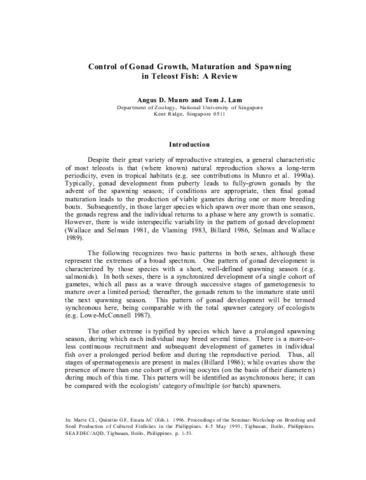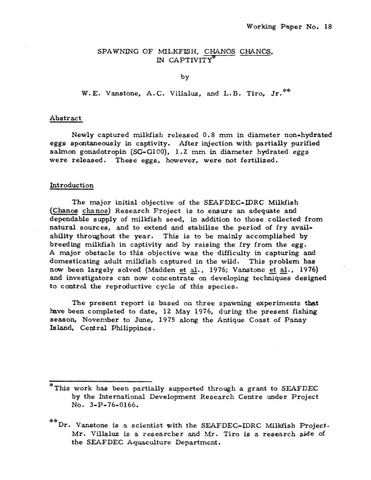Studies on the reproductive biology of the Donkey's ear abalone, Haliotis asinina Linné
| dc.contributor.author | Capinpin, Emmanuel C., Jr. | |
| dc.contributor.author | Encena II, Vincent C. | |
| dc.contributor.author | Bayona, Nestor C. | |
| dc.date.accessioned | 2013-11-15T03:00:11Z | |
| dc.date.available | 2013-11-15T03:00:11Z | |
| dc.date.issued | 1998 | |
| dc.identifier.citation | Capinpin Jr., E. C., Encena II, V. C., & Bayona, N. C. (1998). Studies on the reproductive biology of the Donkey's ear abalone, Haliotis asinina Linné. Aquaculture, 166(1-2), 141-150. | en |
| dc.identifier.issn | 0044-8486 | |
| dc.identifier.uri | http://hdl.handle.net/10862/1734 | |
| dc.description.abstract | The sex ratio, initial size at sexual maturity, spawning period, time interval between successive spawnings and fecundity of the Donkey's ear abalone, Haliotis asinina were studied. The sex ratio of wild abalone (>60 mm shell length) collected from Panagatan Cays, Antique, Philippines was approximately 1:1. Sexual maturity was first attained at a size of 35.0 mm and 35.9 mm for hatchery-reared male and female abalone, respectively, and 40.6 mm for wild-caught male and female specimens. Based on calculated gonad bulk indices and histological observations, wild-caught abalone appeared capable of spawning during most months of the study period except June for males and May–June for females, during which most specimens collected were at a resting stage. This abalone species is a serial spawner with an asynchronous spawning behavior. Hatchery-reared abalone have short time intervals between successive spawnings of 13–15 days. Ripe females measuring 58.1–69 mm in shell length may release about 150,000 to 600,000 eggs per spawning. | en |
| dc.language.iso | en | en |
| dc.publisher | Elsevier | en |
| dc.subject | Haliotis asinina | en |
| dc.subject | Philippines | en |
| dc.subject | Tropical abalone | en |
| dc.subject | Donkey's ear abalone | en |
| dc.title | Studies on the reproductive biology of the Donkey's ear abalone, Haliotis asinina Linné | en |
| dc.type | Article | en |
| dc.identifier.doi | 10.1016/S0044-8486(98)00275-0 | |
| dc.citation.volume | 166 | |
| dc.citation.issue | 1-2 | |
| dc.citation.spage | 141 | |
| dc.citation.epage | 150 | |
| dc.citation.journalTitle | Aquaculture | en |
| seafdecaqd.library.callnumber | VF SJ 0565 | |
| seafdecaqd.databank.controlnumber | 1998-20 | |
| dc.subject.asfa | aquaculture techniques | en |
| dc.subject.asfa | fecundity | en |
| dc.subject.asfa | reproduction | en |
| dc.subject.asfa | hatcheries | en |
| dc.subject.asfa | life history | en |
| dc.subject.asfa | mollusc culture | en |
| dc.subject.asfa | reproductive cycle | en |
| dc.subject.asfa | sex ratio | en |
| dc.subject.asfa | sexual reproduction | en |
| dc.subject.asfa | spawning | en |
Files in this item
| Files | ขนาด | รูป | View |
|---|---|---|---|
|
There are no files associated with this item. |
|||
รายการนี้ปรากฏใน (s)
-
Journal Articles [1229]
These papers were contributed by Department staff to various national and international journals.


